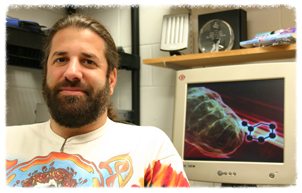Listen to the MP3 Tutor
Estimate Time: 7:00
Vocabulary: hindbrain, midbrain, forebrain, brainstem, medulla oblongata, pons, cerebellum, hypothalamus, thalamus, cerebrum

Hey there. This is Eric Simon, and welcome to another MP3 tutor session for tough terms. In today’s tutorial, I’m going to talk about the anatomy of the human brain. That’s right, we’ll be thinking about the organ that enables you to think! At the end, I’ll give you a brief quiz to test your knowledge. Are you ready to get started? Put on your thinking cap…
Early in embryonic development, the human brain begins to form as an enlargement of the neural tube. The first structures to appear are the three major regions that are named according to their location: the hindbrain, midbrain, and forebrain. Each of these regions will give rise to specific structures in the adult brain.
The hindbrain is the rear most region of the brain and will give rise to the cerebellum and portions of the brainstem. The midbrain is the middle region of the brain and will give rise to the uppermost portions of the brainstem. The cerebrum, the largest and most sophisticated part of our brain, is derived from the forebrain, or frontal portion.
Now that you are oriented to the brain’s three regions, let’s consider brain anatomy in more detail. I will begin at the rear of the brain (the hindbrain) and work my way forward. At the base of the brain is the region that appeared first in evolutionary history, the brainstem.
The brainstem is really an extension of the spinal cord and therefore is an important relay center, providing an avenue for neural signals travelling between the brain and spinal cord. The brainstem also contains a number of regions that control many automatic body functions. The brainstem is divided into three sections: the medulla oblongata, the pons, and the midbrain.
The medulla oblongata contains groups of neurons that regulate a number of vital activities, such as breathing, circulation, and heart rate.
The pons is an enlarged portion of the brainstem that is largely responsible for controlling the rate and depth of breathing.
The topmost region of the brainstem, the midbrain, contains a number of reflex centers that control posture and orientation to sights and sounds. Notice that there is not much “thinking” going on in the brainstem; it primarily regulates basic, unconscious brain functions.
Also located at the rear of the brain is an enlarged structure called the cerebellum, which almost looks like a mini-brain stuck behind the brainstem. The cerebellum assists in coordinating and learning movements. The cerebellum receives sensory information about posture and the location of body parts and processes it to help direct movement. That ends our tour of the hindbrain and midbrain.
Now let’s turn to the forebrain. Above the brainstem and cerebellum are the hypothalamus and thalamus, two major regions of the forebrain. The hypothalamus is the central hub of the endocrine system. For this reason, the hypothalamus is sometimes referred to as the “master control center.” The hypothalamus accomplishes this master regulation by sending commands to the pituitary gland, which then secretes hormones that regulate body functions.
The thalamus is a sensory and motor relay center, monitoring the flow of information between the forebrain and the midbrain. You can think of the thalamus as a traffic cop directing traffic to appropriate places. In addition to this traffic flow, there is also some integration, or “thinking,” that begins to occur at this point in the brain.
The last part of the brain that I will talk about is the cerebrum. The cerebrum is the topmost portion of the brain. Its wrinkly surface covers much of the outside of the brain, and it’s probably what you think of when you imagine what a brain looks like. The cerebrum is divided into left and right cerebral hemispheres, and it performs much of our conscious “thinking.” The thoughts that occur to you as you listen to this information, and hopefully the memories of it that also form, are stored in the cerebrum.
The cerebrum has sensory regions that monitor each of our five senses and motor regions that control our voluntary movement. The cerebrum also contains regions and pathways for emotion, memory, personality, language, and other higher-order functions.
The human cerebrum is proportionally much larger than in other animals. Biologists speculate that our large cerebrum is one of the key factors that distinguishes humans from other organisms. Be sure not to confuse cerebrum (the topmost portion of the forebrain where many of our highest brain functions occur) with the cerebellum (the part of the hindbrain that helps to coordinate movement).
Speaking of higher brain functions, I think it would be helpful if I tested your memory with a brief quiz. I’ll review what we’ve covered. Each time I pause, you say the word that completes the sentence out loud. Trust me, saying these things out loud really will help you remember them. Are you ready?
The base of the brain, which is really an extension of the spinal cord, is called the…
brainstem.
The brainstem can be divided into three regions: the medulla oblongata, the pons, and the…
midbrain.
Behind the brainstem is a structure that is important for coordinating and learning movement, the…
cerebellum.
Above the brainstem is the master control center, the…
hypothalamus,
and a sensory-motor relay center, the…
thalamus.
The topmost and largest region of the human brain, where most of our higher-order thinking occurs, is the…
cerebrum.
I hope this tutorial helped you learn about the anatomy of the human brain. If you need more help, you can listen to it again, or consult your textbook and lecture notes. Good luck with your studying, and remember: when people tell you to wear your thinking cap, they probably mean your cerebrum!

